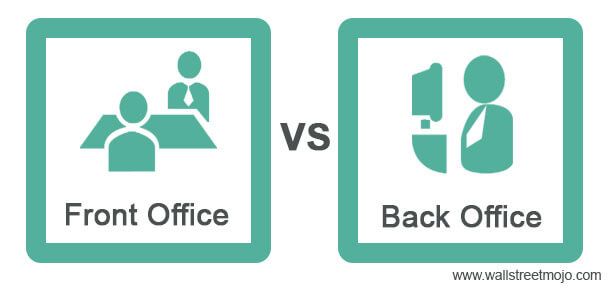Table Of Contents
Difference Between Front Office and Back Office
These terms are used to define different business processes within the organization where the primary responsibility of interacting with the customers is endowed to the front office, and all the production and background processing of the tasks that are required to deliver a quality product or service lies with the back office hence both are pivotal parts of an organization.

We often hear these terms while referring to official work and different responsibilities. Both are different areas of the building area or the room where the employees work. Both are those places where the employees perform clerical jobs or professional activities and other activities related to the smooth running of the business.
What is the Front Office?
The section of the office that takes on the responsibility of interacting with the company's clients, be it existing or new, is known as a Front office. This section also handles the tasks of sales and marketing services along with providing after-sales services. The employees should possess good skills to be a part of this team.
The employees working in the front office directly interact and have dealings with the company's customers. They are the ones who have the duty of taking and placing orders on behalf of the customers and ensuring that the customers are highly satisfied with the services provided. Since it handles customer satisfaction, this section is highly responsible for the company's growth in revenues.
What is the Back Office?
The back office section of a company mainly consists of the administration department. This section ensures that all the operations are performed seamlessly so that the daily business is run smoothly. The employees in this section do not have direct interaction with the company's customers.
It helps in daily administration work and the development and manufacturing of the products and services. Though they have no direct contact with the customers, the back-office employees are an integral part of the company as they are responsible for handling daily activities.
Video Explanation of Front Office
Front Office vs Back Office Infographics

Key Differences
The followings are the key differences:
- The front office of a company handles direct communication with existing and new customers, whereas the back office has no interaction with the customers.
- The front office has sales and marketing departments, whereas the back office has the admin department, finance and accounting department, HR department, warehousing, etc.
- The main responsibility of the front office is to generate revenue and increase the company's revenue. In contrast, the other's duty is reducing the overall costs for the business.
- The front office helps develop the strategy to capture new deals, whereas the back office helps ensure compliance management.
- The front office tries to generate new deals so that the business increases, whereas the back office focuses on manufacturing goods and services.
- An important point of difference arises when salary comes into play. Since the front office employees are the ones who generate the revenue for the organization, the salary earned by the front office employees is higher than employees in the back office.
- Though the front office employees try to think that they are the ones who are doing the most important function, the reality is they are highly dependent on the workings of the other side as they ensure that all the processes are run well, be it admin, HR or IT. Moreover, over the years, the roles of some back-office functions have evolved exponentially. For example, earlier, the role of IT was mostly confined to hardware. Still, nowadays, the IT team in investment banks comprises people who develop important technical infrastructure that enables the core operation.
Comparative Table
| Basis | Front Office | Back Office |
|---|---|---|
| 1. Definition | It is a section that directly interacts with customers. | It is a section that handles daily administration functions. |
| 2. Customer Involvement | It has direct involvement and interaction with customers. | It has no direct involvement or interaction with the customers. |
| 3. Strategy | It helps in strategy development. | It is responsible for HR functions and compliance management. |
| 4. Core function | It helps in increasing demands and sales. | It helps in the manufacturing of products and services. |
| 5. Responsibility | Its main function is to look after sales, marketing, and after-sales services. | Its main function is to look after the daily admin processes to run smoothly. |
| 6. Salary | Since the front office employees are the ones who generate the revenue for the organization, the salary earned by the front office employees is higher. | Generally lower than front-office employees for most of the functions, though some functions are evolving nowadays, which can match the other side. |
| 7. Focus Area | It aims at increasing the revenue of the business. | It aims at cost reduction. |
| 8. Interactions | Its main duty is selling and interacting with the clients of the company. | It helps support functions like IT management, Finance, accounting, warehousing, etc. |
Conclusion
Both play important roles in growing the organization and making sure all the organization's operations are running seamlessly. Though traditionally it used to be that the front office employees are the ones who generate revenues and get paid better, the gap is gradually and surely decreasing in most of the organizations with the use of more and more technology over the years.
Many functions done by the clients are executed with the help of technology, mainly for the whole BFSI sector. It led to the growing prominence of the back-office employees and enabled them to contribute more to the revenue generation part of the business.
